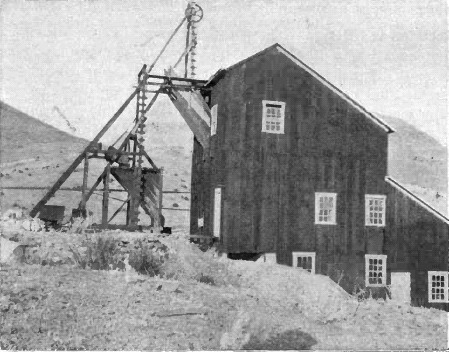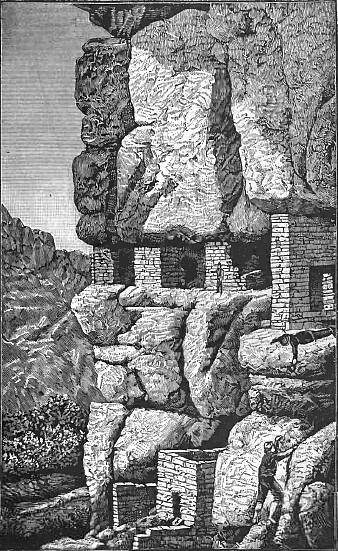In Pinal County, which was organized from parts of Maricopa, Pima and Yavapai in 1875, 975 mining claims were recorded by 1876. The county in its early days was noted for its richness in silver mines. Nine tons of ore from the Stonewall Jackson yielded $200,000 in silver, and in 1881 the Mack Morris mine in Richmond Basin produced $300,000 of the same metal, but the greatest of all of the county's silver mines, indeed the greatest in the State, was the wonderful Silver King, on the western side of the Pinal range, whose mill was located at Pinal. It was discovered, in 1872, by a soldier by the name of Sullivan who had no proper appreciation of the value of the black, metallic native silver lumps which flattened when he pounded them with a hammer.
Charles G. Mason, a rancher for whom Sullivan afterwards worked, knew about the lumps of silver, and later, after Sullivan had left his employ, made several attempts to find the lost mine. In 1875 Mason, with four companions, while returning from the Silver Queen in the Globe district with a pack train of ore, was attacked by Apaches and one of their number killed. The body was buried at a temporary military post at the summit of Stoneman's grade called Camp Supply, and when the miners reached the bottom of the grade, Isaac Copeland, one of the party, went in search of a mule and found it standing on some croppings at the side of the trail. He broke off a piece of the metal; one look at it was enough. It was the black stuff that Mason had talked about! The lost mine was found! A partnership to own the Silver King, as the property was christened, was formed, with each of the party Mason, Copeland, W. H. Long, and B. W. Regan taking one-fourth interest. Copeland and Long soon sold out to their partners for $80,000, and the two who stayed in made more than that out of the profits during the next six months. Mason, who then thought it was a good time to sell, parted with his holdings to Col. S. M. Barney, of Yuma, for a quarter of a million dollars, and Ragan also later sold his interest to Barney for three hundred thousand.
The editor of the Pinal Drill puts a fine denouement on the story. "Several years later when the Silver King was in full operation an aged man came slowly into the settlement of "Picket Post" (Pinal's original name) and gazed with interest at the busy scene about him. He went to the office of the Company and announced himself as Sullivan, the old soldier, the original discoverer of the mine, and asked for work. He was identified, and taken into the Company's employ. He had been working as a farm hand in California, trying to obtain sufficient means to return to Arizona."
The Silver Queen referred to in the Silver King story was abandoned after being worked a number of years because, as the workings went deeper in the ground, the silver ore was so mixed with copper that, with the then methods, it could not be worked with profit. Now it is the successful Magma mine producing native gold, silver and copper, working 275 men and taking out 225 tons of ore daily. Pinal County's placer mines are limited to the "Old Hat" district where $7,106 in gold was mined from 1903 to 1912. There is a tradition of a lump of gold weighing 16 pounds being found in the gravel and that the finder was murdered for his treasure. Within the counties of Pima and Santa Cruz, wherein lies the Santa Cruz Valley, which, as we have seen, was the home of the earliest worked mines in Arizona, are still to be found properties rich in gold, silver, copper and lead. The World's Fair mine, situated two miles west of Harshaw, located in 1879, has produced since that date over a million of dollars in the four principal Arizona metals.
The R. R. R. mine in the Palermo district is also a million dollar producer, its total products equaling that amount between May, 1911, and October, 1914. It is now closed on account of litigation. Placer mines in the Quijotoa district washed out $30,268 in gold between 1903 and 1912, and in the Greaterville district $30,294 within the same period. It is estimated that the total Greaterville placer production to date amounts to $7,000,000.
Aside from the copper mines, which are considered elsewhere, the rich silver mines of the Tombstone district occupy first place in Cochise County history, both as to value of output and romantic interest. In the winter of 1877-1878 a tall, lanky prospector drove his burro over the Apache-infested mountains east of the San Pedro. His clothing was worn and patched with deer and rabbit skins, his long, scraggy beard was as unkempt as his hair. His name was Ed Schieffelin. One day as he started out from the Brunckow mines, where he had been doing assessment work, a friend shouted to him, "Whar ye goin', Ed?" "Just over the hills to look for stones," called back the prospector. "Wait" commented the friend cheerfully, "the most likely stone for you to find will be your tombstone." After that, when Schieffelin came upon the rich silver float, and traced it to a ledge which looked wonderfully promising, he said grimly, "This tombstone is sure good enough for me." Schieffelin took a sample of the ore to the Signal Mill in Mojave County, where his brother was living. Much impressed by its richness, as well as by Schieffelin's story, a party was made up, and returned to the claim. Although the original location was of but moderate value, later claims were richer, and soon the Tombstone silver boom was on.
Following the usual custom in telling of the discovery of a mine, we now introduce a mule in fact, several. These particular mules belonged to Ed Williams, and one of them, as he wandered off, trailed a tie-chain behind him. The next morning, following the trail, Williams noticed a metallic gleam where the chain had worn the surface of the rock, and, behold, the great Contention mine was discovered! To settle the "contention" that gave the claim its name, Williams and his partner took the upper end of the property, which they called the Grand Central, and Schieffelin and his friends acquired the lower the Contention. Schieffelin soon sold the Contention for $10,000. Afterwards it produced millions. The seven big mining companies operating in the Tombstone district were, the Contention, Consolidated, the Tombstone Mining Co., the Grand Central, the Empire, the Stonewall and the Vizina. At a depth of 500 feet water was struck in the Sulfide shaft and in such quantities that the cost to pump it was practically prohibitive. However, pumps were installed in the Contention and the Grand Central, but the underground flow ran from one mine to another, and as the owners of the other properties refused to join with the companies which were pumping, work of necessity was soon abandoned. The final shutting down of the Contention occurred in 1886 when the surface works burned.
An attempt was made by E. B. Gage and associates, in 1901, to once more operate the Tombstone mines. They sunk a new shaft near the old Contention, going down 1,080 feet. When water was encountered they installed the most efficient system of pumps their engineers could devise, but the result was a failure. At the maximum they were pumping 8,000,000 gallons of water a day, for which time the fuel cost alone was $700.
Return
to The Arizona Page:
Arizona Gold Rush Mining History



